Multi-Scale Dynamic Analysis of the Russian–Ukrainian Conflict from the Perspective of Night-Time Lights
Abstract
1. Introduction
2. Literature Reveiew
3. Study Area and Data
3.1. Study Area
3.2. Data Sets and Preprocessing
4. Methods
4.1. Multiscale Analysis Frame of the Night-Time Light Data
4.2. City Mask Extraction
4.3. Night-Time Light Ratio Index
4.4. Night-Time Light Dynamics
5. Results
5.1. Dynamic Analysis of Night-Time Light Changes at the National Scale
5.2. Dynamic Analysis of Night-time Light Changes at the Regional Scale
5.3. Dynamic Analysis of Night-Time Light Changes at the Urban Scale
5.4. Dynamic Analysis of Night-Time Light Changes at the Road Scale
6. Discussion and Conclusions
Author Contributions
Funding
Institutional Review Board Statement
Informed Consent Statement
Data Availability Statement
Acknowledgments
Conflicts of Interest
References
- AbuZayd, K.; Sullivan, D.J.; Akram, S.M.; Roy, S. The Syrian Humanitarian Crisis: What Is to Be Done? Middle East Policy 2015, 22, 1–29. [Google Scholar] [CrossRef]
- Li, X.C.; Zhou, Y.Y.; Zhao, M.; Zhao, X. A harmonized global nighttime light dataset 1992–2018. Sci. Data 2020, 7, 168. [Google Scholar] [CrossRef] [PubMed]
- Yu, B.; Shi, K.; Hu, Y.; Huang, C.; Chen, Z.; Wu, J. Poverty Evaluation Using NPP-VIIRS Nighttime Light Composite Data at the County Level in China. IEEE J. Sel. Top. Appl. Earth Obs. Remote Sens. 2015, 8, 1217–1229. [Google Scholar] [CrossRef]
- Li, X.; Chen, F.; Chen, X. Satellite-Observed Nighttime Light Variation as Evidence for Global Armed Conflicts. IEEE J. Sel. Top. Appl. Earth Obs. Remote Sens. 2013, 6, 2302–2315. [Google Scholar] [CrossRef]
- Collin, G.H.; Cameron, L.A.; Debra, K.; Spencer, J.S. Multi-scale remote sensing sagebrush characterization with regression trees over Wyoming, USA: Laying a foundation for monitoring. Int. J. Appl. Earth Obs. Geoinf. 2012, 14, 233–244. [Google Scholar] [CrossRef]
- Sutton, P.; Roberts, D.; Elvidge, C.; Baugh, K. Census from Heaven: An estimate of the global human population using night-time satellite imagery. Int. J. Remote Sens. 2001, 22, 3061–3076. [Google Scholar] [CrossRef]
- Bharti, N.; Tatem, A.J.; Ferrari, M.J.; Grais, R.F.; Djibo, A.; Grenfell, B.T. Explaining Seasonal Fluctuations of Measles in Niger Using Nighttime Lights Imagery. Science 2011, 334, 1424–1427. [Google Scholar] [CrossRef]
- Levin, N.; Zhang, Q.L. A global analysis of factors controlling VIIRS nighttime light levels from densely populated areas. Remote Sens. Environ. 2017, 190, 366–382. [Google Scholar] [CrossRef]
- Bagan, H.; Yamagata, Y. Analysis of urban growth and estimating population density using satellite images of nighttime lights and land-use and population data. GISci. Remote Sens. 2015, 52, 765–780. [Google Scholar] [CrossRef]
- Liu, Z.F.; He, C.Y.; Zhang, Q.F.; Huang, Q.; Yang, Y. Extracting the dynamics of urban expansion in China using DMSP-OLS nighttime light data from 1992 to 2008. Landsc. Urban Plan. 2012, 106, 62–72. [Google Scholar] [CrossRef]
- Yi, K.; Tani, H.; Li, Q.; Zhang, J.; Guo, M.; Bao, Y.; Wang, X.; Li, J. Mapping and Evaluating the Urbanization Process in Northeast China Using DMSP/OLS Nighttime Light Data. Sensors 2014, 14, 3207–3226. [Google Scholar] [CrossRef] [PubMed]
- Ma, T.; Zhou, Y.; Zhou, C.; Haynie, S.; Pei, T.; Xu, T. Night-time light derived estimation of spatio-temporal characteristics of urbanization dynamics using DMSP/OLS satellite data. Remote Sens. Environ. 2015, 158, 453–464. [Google Scholar] [CrossRef]
- Ma, X.; Tong, X.; Liu, S.; Luo, X.; Xie, H.; Li, C. Optimized Sample Selection in SVM Classification by Combining with DMSP-OLS, Landsat NDVI and GlobeLand30 Products for Extracting Urban Built-Up Areas. Remote Sens. Multidiscip. Digit. Publ. Inst. 2017, 9, 236. [Google Scholar] [CrossRef]
- Li, G.; Zhang, H.; Chen, S.; Qiu, J.; Wang, X. Assessing the impact of urban development on net primary productivity during 2000–2010 in Taihu Basin. Environ. Earth Sci. 2016, 75, 1266. [Google Scholar] [CrossRef]
- Zhang, Q.; Seto, K.C. Mapping urbanization dynamics at regional and global scales using multi-temporal DMSP/OLS nighttime light data. Remote Sens. Environ. 2011, 115, 2320–2329. [Google Scholar] [CrossRef]
- Li, X.; Zhao, L.; Li, D.; Xu, H. Mapping Urban Extent Using Luojia 1-01 Nighttime Light Imagery. Sensors 2018, 18, 3665. [Google Scholar] [CrossRef]
- Liu, L.; Li, Z.; Fu, X.; Liu, X.; Li, Z.; Zheng, W. Impact of Power on Uneven Development: Evaluating Built-Up Area Changes in Chengdu Based on NPP-VIIRS Images (2015–2019). Land 2022, 11, 489. [Google Scholar] [CrossRef]
- Levin, N.; Kark, S.; Crandall, D. Where have all the people gone? Enhancing global conservation using night lights and social media. Ecol. Appl. 2015, 25, 2153–2167. [Google Scholar] [CrossRef]
- Jiang, S.; Wei, G.; Zhang, Z.; Wang, Y.; Xu, M.; Wang, Q.; Das, P.; Liu, B. Detecting the Dynamics of Urban Growth in Africa Using DMSP/OLS Nighttime Light Data. Land 2021, 10, 13. [Google Scholar] [CrossRef]
- Elvidge, C.D.; Sutton, P.C.; Ghosh, T.; Tuttle, B.T.; Baugh, K.E.; Bhaduri, B.; Bright, E. A global poverty map derived from satellite data. Comput. Geosci. 2009, 35, 1652–1660. [Google Scholar] [CrossRef]
- Shi, K.; Yu, B.; Huang, Y.; Hu, Y.; Yin, B.; Chen, Z.; Chen, L.; Wu, J. Evaluating the Ability of NPP-VIIRS Nighttime Light Data to Estimate the Gross Domestic Product and the Electric Power Consumption of China at Multiple Scales: A Comparison with DMSP-OLS Data. Remote Sens. 2014, 6, 1705–1724. [Google Scholar] [CrossRef]
- Letu, H.; Hara, M.; Yagi, H.; Naoki, K.; Tana, G.; Nishio, F.; Shuhei, O. Estimating energy consumption from night-time DMPS/OLS imagery after correcting for saturation effects. Int. J. Remote Sens. 2010, 31, 4443–4458. [Google Scholar] [CrossRef]
- Zhong, Y.; Lin, A.; Xiao, C.; Zhou, Z. Research on the Spatio-Temporal Dynamic Evolution Characteristics and Influencing Factors of Electrical Power Consumption in Three Urban Agglomerations of Yangtze River Economic Belt, China Based on DMSP/OLS Night Light Data. Remote Sens. 2021, 13, 1150. [Google Scholar] [CrossRef]
- Elvidge, C.D.; Ziskin, D.; Baugh, K.E.; Tuttle, B.T.; Ghosh, T.; Pack, D.W.; Erwin, E.H.; Zhizhin, M. A Fifteen Year Record of Global Natural Gas Flaring Derived from Satellite Data. Energies 2009, 2, 595–622. [Google Scholar] [CrossRef]
- Agnew, J.; Gillespie, T.; Gonzalez, J.; Min, B. Baghdad Nights: Evaluating the US Military ‘Surge’ Using Nighttime Light Signatures. Environ. Plan. A 2008, 40, 2285–2295. [Google Scholar] [CrossRef]
- Pathmasiri, E.; Kim, M. Influence of intra annual calibration methods in changing the preciseness of the obtainable information from DMSP-OLS NLT images. Int. J. Res. Publ. 2018, 4, 1–15. [Google Scholar]
- Witmer, F.D.W.; O’Loughlin, J. Detecting the Effects of Wars in the Caucasus Regions of Russia and Georgia Using Radiometrically Normalized DMSP-OLS Nighttime Lights Imagery. GISci. Remote Sens. 2011, 48, 478–500. [Google Scholar] [CrossRef]
- Li, X.; Li, D. Can night-time light images play a role in evaluating the Syrian Crisis? Int. J. Remote Sens. 2014, 35, 6648–6661. [Google Scholar] [CrossRef]
- Elvidge, C.D.; Baugh, K.E.; Zhizhin, M.; Hsu, F.C. Why VIIRS data are superior to DMSP for mapping nighttime lights. Proc. Asia Pac. Adv. Netw. 2013, 35, 62. [Google Scholar] [CrossRef]
- Dou, Y.; Liu, Z.; He, C.; Yue, H. Urban Land Extraction Using VIIRS Nighttime Light Data: An Evaluation of Three Popular Methods. Remote Sens. 2017, 9, 175. [Google Scholar] [CrossRef]
- Ajmar, A.; Arco, E.; Eusebio, A. The VIIRS Nighttime Lights average annual global dataset: Exploratory and brisk trend analysis on three different domains. In Proceedings of the IEEE 21st Mediterranean Electrotechnical Conference (MELECON), Palermo, Italy, 14–16 June 2022; pp. 454–459. [Google Scholar] [CrossRef]
- Zheng, Z.; Wu, Z.; Cao, Z.; Zhang, Q.; Chen, Y.; Guo, G.; Yang, Z.; Guo, C.; Wang, X.; Marinello, F. Estimates of Power Shortages and Affected Populations during the Initial Period of the Ukrainian-Russian Conflict. Remote Sens. 2022, 14, 4793. [Google Scholar] [CrossRef]
- Elvidge, C.D.; Zhizhin, M.; Ghosh, T.; Hsu, F.-C.; Taneja, J. Annual Time Series of Global VIIRS Nighttime Lights Derived from Monthly Averages: 2012 to 2019. Remote Sens. 2021, 13, 922. [Google Scholar] [CrossRef]
- Nicolae, R.A. Using NASA’s Fire Information for Resource Management System (FIRMS) to evaluate the impact of war in Ukraine on environment during the first month of conflict. In Proceedings of the 17th Present Environment and Sustainable Development, Iași, Romania, 3 June 2022; p. 62. [Google Scholar]
- Zheng, Q.M.; Weng, Q.H.; Wang, K. Developing a new cross-sensor calibration model for DMSP-OLS and Suomi-NPP VIIRS night-light imageries. ISPRS J. Photogramm. Remote Sens. 2019, 153, 36–47. [Google Scholar] [CrossRef]
- Hao, M.; Zhou, Y.Y.; Li, X.C.; Zhou, C.H.; Cheng, W.M.; Li, M.C.; Huang, K. Building a Series of Consistent Night-Time Light Data (1992–2018) in Southeast Asia by Integrating DMSP-OLS and NPP-VIIRS. IEEE Trans. Geosci. Remote Sens. 2019, 58, 1–14. [Google Scholar] [CrossRef]
- Li, X.; Li, D.; Xu, H.; Wu, C. Intercalibration between DMSP/OLS and VIIRS night-time light images to evaluate city light dynamics of Syria’s major human settlement during Syrian Civil War. Int. J. Remote Sens. 2017, 38, 1–18. [Google Scholar] [CrossRef]
- Jiang, W.; He, G.; Long, T.; Liu, H. Ongoing Conflict Makes Yemen Dark: From the Perspective of Nighttime Light. Remote Sens. 2017, 9, 798. [Google Scholar] [CrossRef]
- Yang, W.T.; Deng, M.; Tang, J.B.; Luo, L. Geographically weighted regression with the integration of machine learning for spatial prediction. J. Geogr. Syst. 2022. [Google Scholar] [CrossRef]
- Baumann, M.; Kuemmerle, T.; Elbakidze, M.; Ozdogan, M.; Radeloff, V.C.; Keuler, N.S.; Prishchepov, A.V.; Kruhlov, I.; Hostert, P. Patterns and drivers of post-socialist farmland abandonment in Western Ukraine. Land Use Policy 2011, 28, 552–562. [Google Scholar] [CrossRef]
- Zhao, X.; Yu, B.; Liu, Y.; Yao, S.; Lian, T.; Chen, L.; Yang, C.; Chen, Z.; Wu, J. NPP-VIIRS DNB Daily Data in Natural Disaster Assessment: Evidence from Selected Case Studies. Remote Sens. 2018, 10, 1526. [Google Scholar] [CrossRef]
- Li, X.; Liu, S.; Jendryke, M.; Li, D.; Wu, C. Night-Time Light Dynamics during the Iraqi Civil War. Remote Sens. 2018, 10, 858. [Google Scholar] [CrossRef]
- Zhou, Y.; Smith, J.S.; Elvidge, D.C.; Zhao, K.; Thomson, A.; Imhoff, M. A cluster-based method to map urban area from DMSP/OLS nightlights. Remote Sens. Environ. 2014, 147, 173–185. [Google Scholar] [CrossRef]
- Li, X.; Zhang, R.; Huang, C.; Li, D. Detecting 2014 Northern Iraq Insurgency using night-time light imagery. Int. J. Remote Sens. 2015, 36, 3446–3458. [Google Scholar] [CrossRef]
- Li, Q.; Lu, L.; Weng, Q.; Xie, Y.; Guo, H. Monitoring Urban Dynamics in the Southeast U.S.A. Using Time-Series DMSP/OLS Nightlight Imagery. Remote Sens. 2016, 8, 578. [Google Scholar] [CrossRef]
- Zhao, Z.; Cheng, G.; Wang, C.; Wang, S.; Wang, H. City Grade Classification Based on Connectivity Analysis by Luojia I Night-Time Light Images in Henan Province, China. Remote Sens. 2020, 12, 1705. [Google Scholar] [CrossRef]

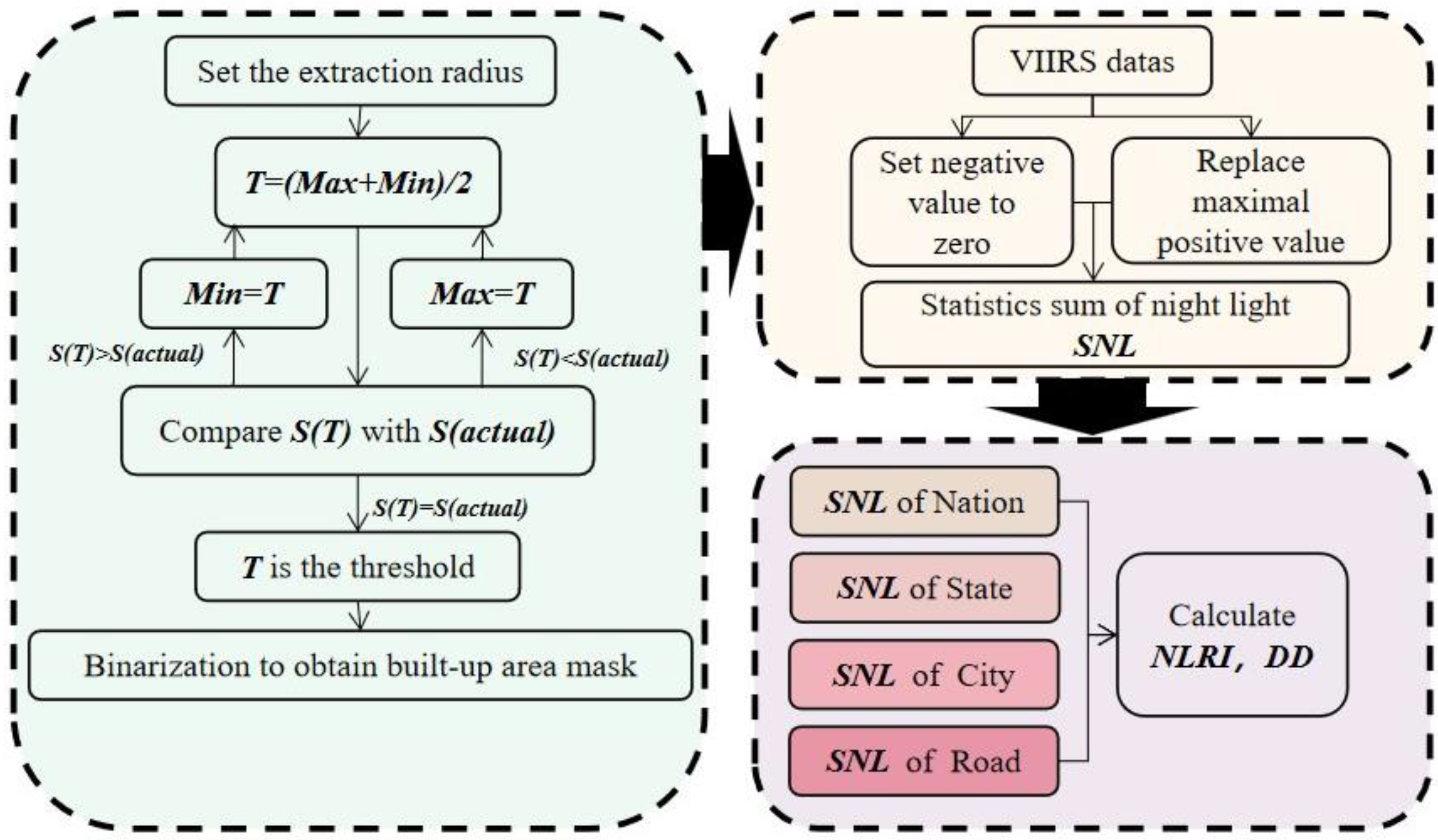
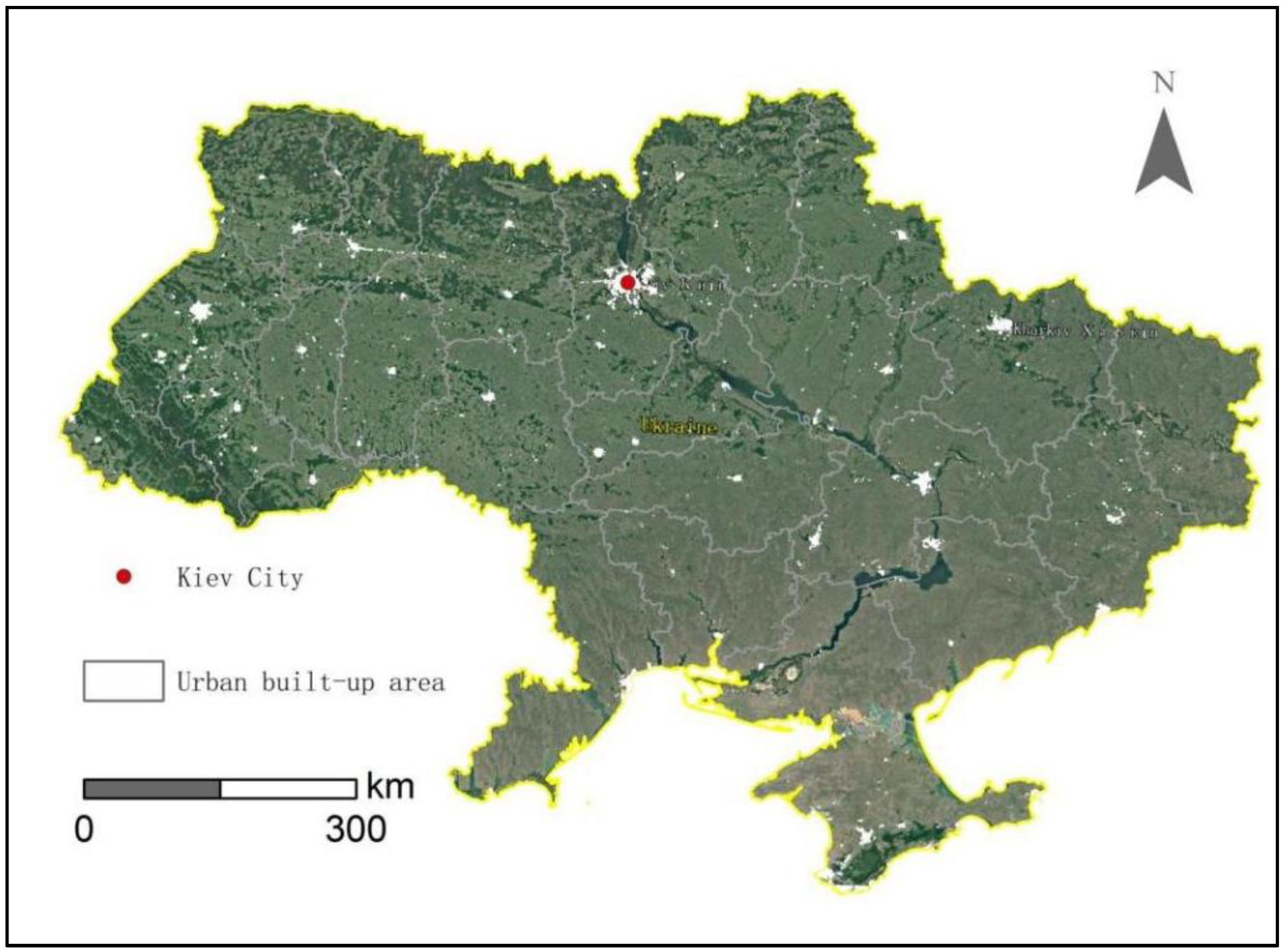

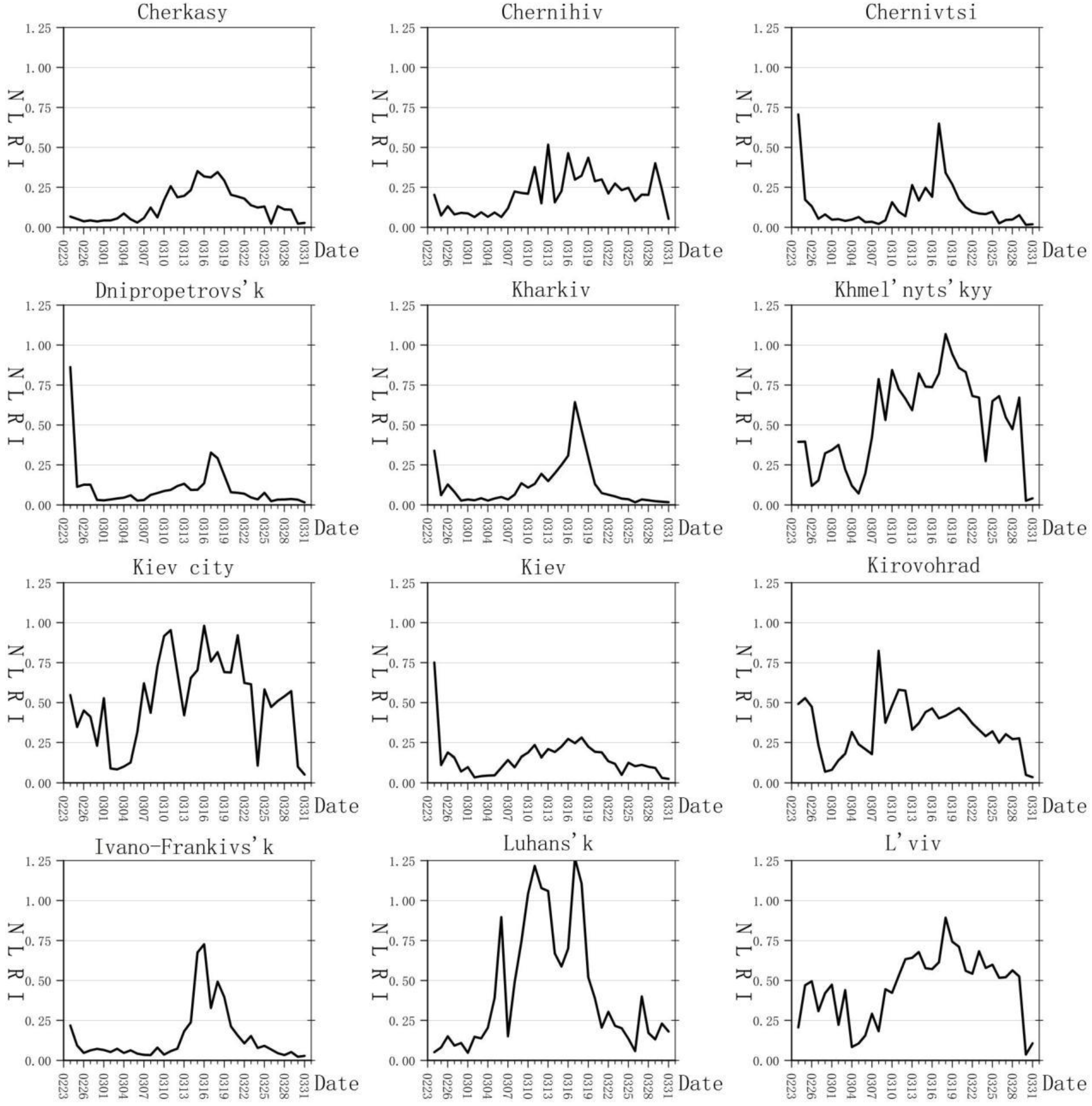
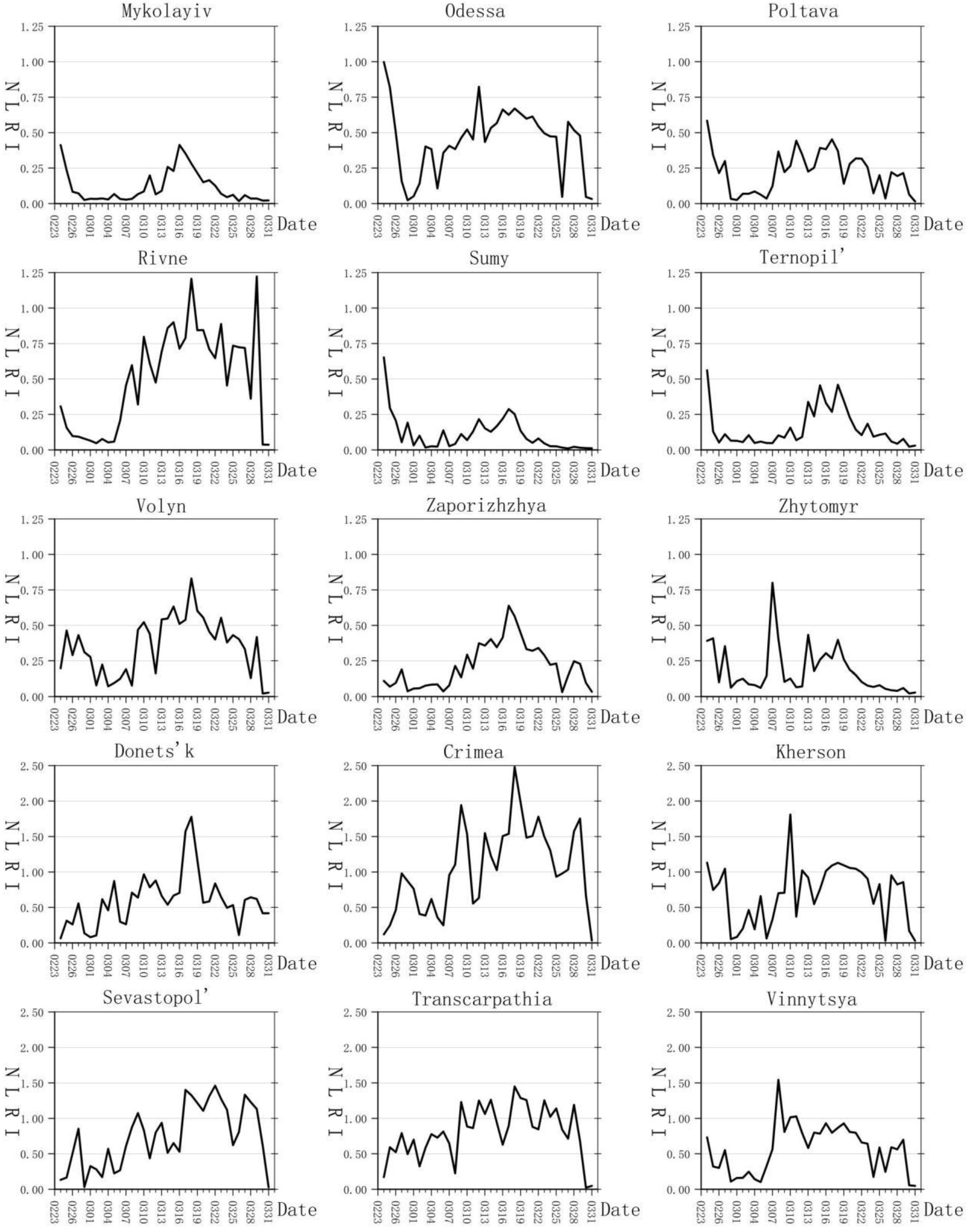
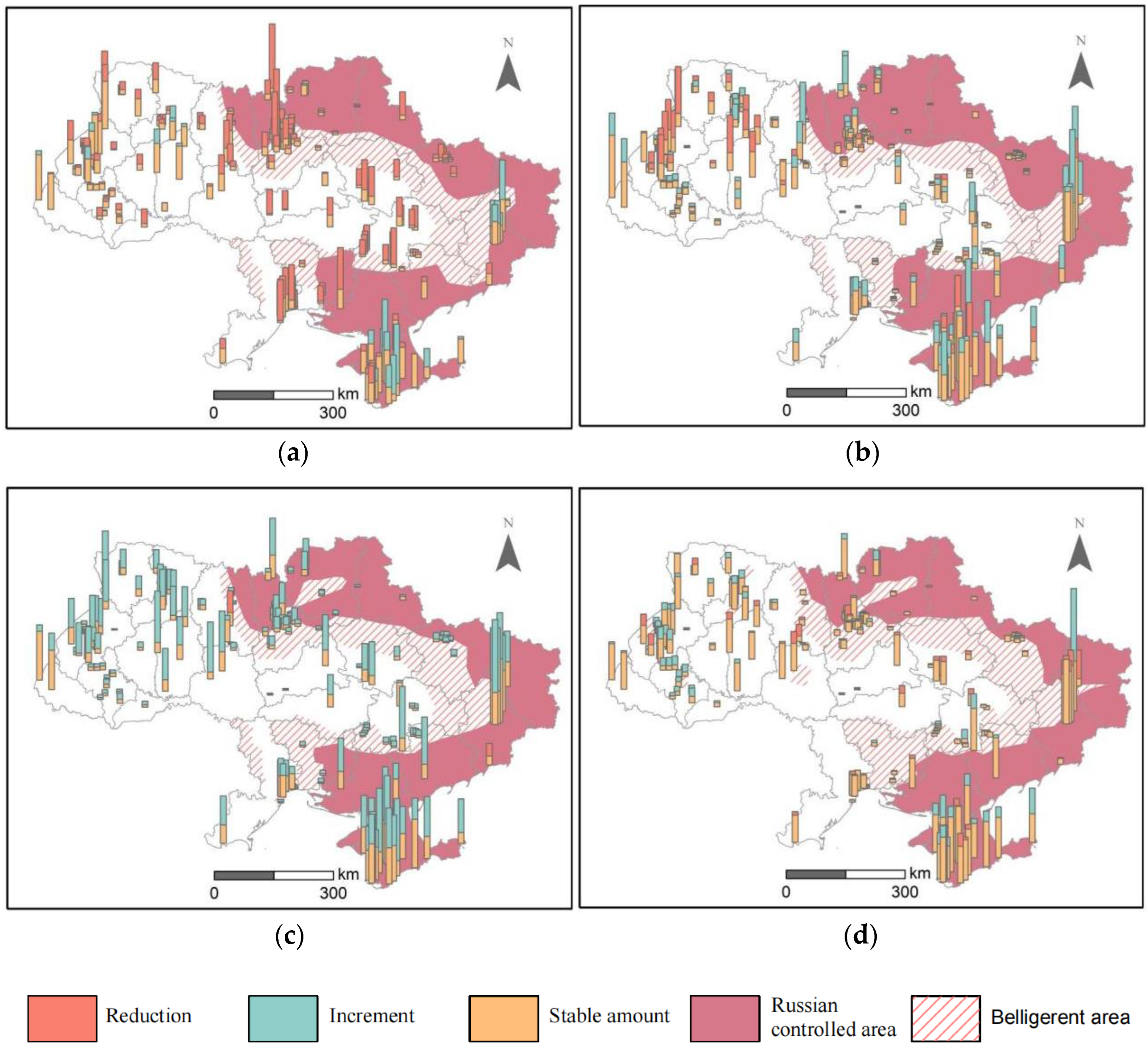
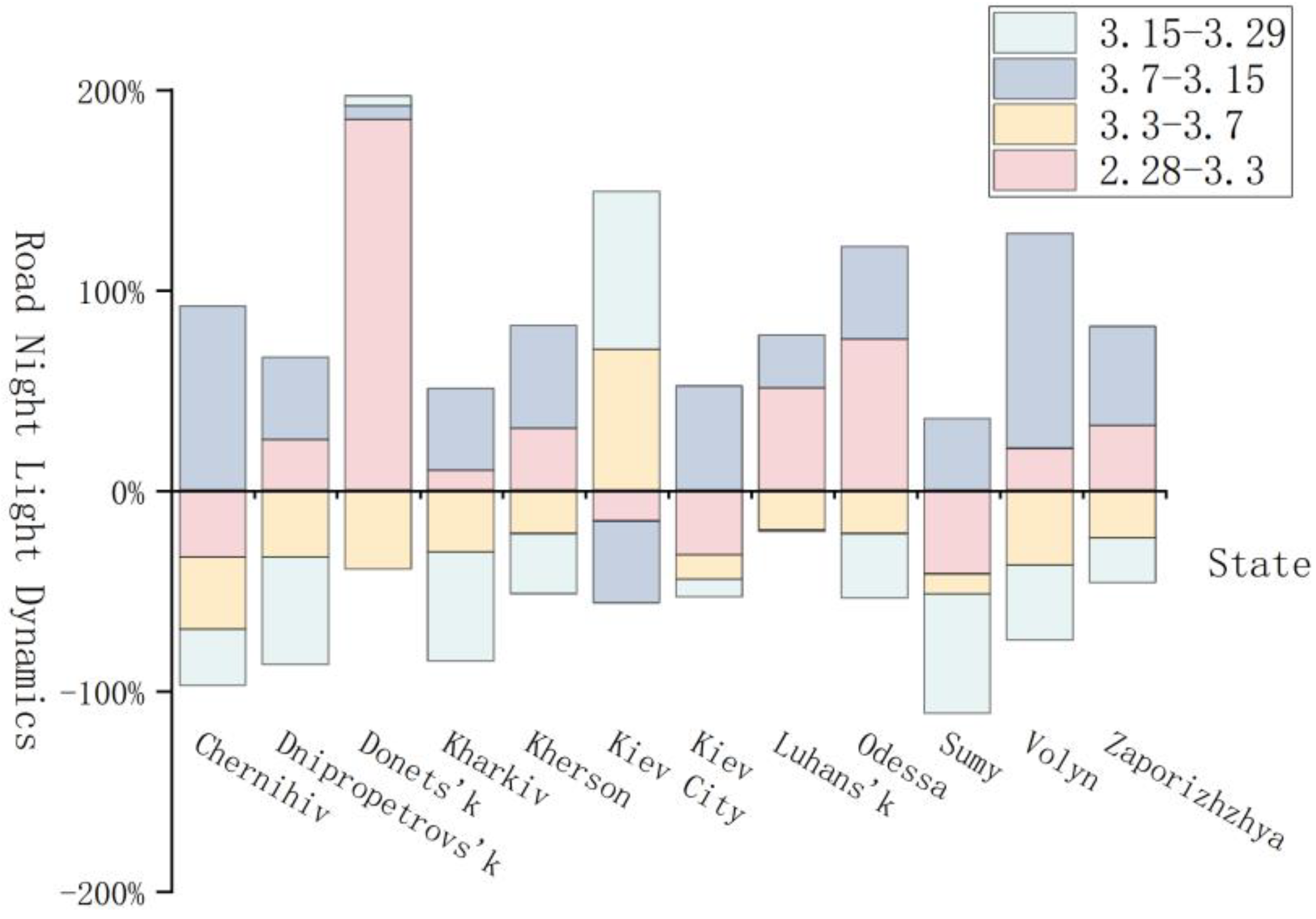
| State | Type | Outbreak of Conflict | The First Negotiation | The Second Negotiation | Humanitarian Corridor | The Third Negotiation |
|---|---|---|---|---|---|---|
| Date | 2.24 — | 0228 | 0303 | 3.5 — | 3.7 | |
| Impact | - | + | + | + | + | |
| Cherkasy | UC | -- | -- | -- | -- | -- |
| Chernivtsi | B | IN | IN | IN | IN | IN |
| Dnipropetrovs’k | B | IN | IN | IN | IN | IN |
| Donets’k | RC | IN | IN | -- | IN | -- |
| Kharkiv | B | IN | IN | IN | IN | IN |
| Kiev City | B | IN | IN | IN | IN | IN |
| Zaporizhzhya | RC | IN | IN | IN | IN | -- |
| State | Type | Multinational Intervention | The Fourth Negotiation | Conflict Escalation | The Fifth Negotiation | Russian Troops Withdraw |
| Date | 3.14 — | 3.15 | 3.20 — | 3.29 | ||
| Impact | - | + | - | + | + | |
| Cherkasy | UC | IN | -- | -- | -- | -- |
| Chernivtsi | B | IN | IN | IN | IN | -- |
| Dnipropetrovs’k | B | -- | IN | IN | IN | -- |
| Donets’k | RC | -- | -- | -- | -- | -- |
| Kharkiv | B | -- | IN | IN | IN | -- |
| Kiev City | B | IN | IN | IN | IN | IN |
| Zaporizhzhya | RC | -- | -- | -- | -- | -- |
| Region | Average Night-Time Light Ratio Index | Region | Average Night-Time Light Ratio Index | Region | Average Night-Time Light Ratio Index | ||||||
|---|---|---|---|---|---|---|---|---|---|---|---|
| Cherkasy | 0.05 | 0.17 | 0.11 | Khmel’nyts’kyy | 0.28 | 0.59 | 0.50 | Rivne | 0.15 | 0.53 | 0.59 |
| Chernihiv | 0.12 | 0.22 | 0.23 | Kiev | 0.26 | 0.16 | 0.10 | Sevastopol’ | 0.34 | 0.71 | 0.99 |
| Chernivtsi | 0.23 | 0.15 | 0.07 | Kiev City | 0.40 | 0.56 | 0.46 | Sumy | 0.28 | 0.12 | 0.03 |
| Crimea | 0.54 | 1.12 | 1.19 | Kirovohrad | 0.36 | 0.38 | 0.27 | Ternopil’ | 0.18 | 0.18 | 0.09 |
| Dnipropetrovs’k | 0.25 | 0.10 | 0.04 | L’viv | 0.48 | 0.57 | 0.48 | Transcarpathia | 0.51 | 0.89 | 0.78 |
| Donets’k | 0.27 | 0.72 | 0.54 | Luhans’k | 0.10 | 0.64 | 0.20 | Vinnytsya | 0.40 | 0.67 | 0.46 |
| Ivano-Frankivs’k | 0.10 | 0.20 | 0.08 | Mykolayiv | 0.17 | 0.13 | 0.06 | Volyn | 0.44 | 0.47 | 0.32 |
| Kharkiv | 0.13 | 0.17 | 0.04 | Odessa | 0.50 | 0.46 | 0.39 | Zaporizhzhya | 0.10 | 0.26 | 0.20 |
| Kherson | 0.76 | 0.71 | 0.65 | Poltava | 0.29 | 0.23 | 0.17 | Zhytomyr | 0.26 | 0.22 | 0.07 |
| Region | Density of Road Network (km/km2) | The Total of Road Lights at Night (nW/cm2/sr) | Road Night-Time Light Dynamics (%) | |||||||
|---|---|---|---|---|---|---|---|---|---|---|
| 2.28 | 3.3 | 3.7 | 3.15 | 3.29 | 2.28–3.3 | 3.3–3.7 | 3.7–3.15 | 3.15–3.29 | ||
| Chernihiv | 0.105 | 47,242 | 31,410 | 20,109 | 38,625 | 27,851 | −33.51% | −35.98% | 92.08% | −27.89% |
| Dnipropetrovs’k | 0.110 | 26,337 | 32,984 | 21,979 | 31,017 | 14,347 | 25.24% | −33.37% | 41.12% | −53.74% |
| Donets’k | 0.099 | 24,064 | 68,628 | 41,640 | 44,522 | 46,742 | 185.19% | −39.32% | 6.92% | 4.99% |
| Kharkiv | 0.084 | 24,226 | 26,644 | 18,410 | 25,941 | 11,820 | 9.98% | −30.90% | 40.91% | −54.44% |
| Kherson | 0.058 | 10,703 | 14,014 | 10,985 | 16,622 | 11,615 | 30.93% | −21.61% | 51.31% | −30.13% |
| Kiev City | 0.559 | 15,016 | 12,711 | 21,671 | 12,809 | 28,899 | −15.35% | 70.49% | −40.89% | 78.69% |
| Kiev | 0.100 | 41,577 | 28,148 | 24,758 | 37,665 | 34,302 | −32.30% | −12.04% | 52.13% | −8.93% |
| Luhans’k | 0.073 | 20,656 | 31,233 | 25,029 | 31,625 | 31,346 | 51.20% | −19.86% | 26.36% | −0.88% |
| Odessa | 0.094 | 23,144 | 40,629 | 31,860 | 46,573 | 31,550 | 75.55% | −21.58% | 46.18% | −32.26% |
| Sumy | 0.096 | 32,106 | 18,703 | 16,827 | 22,837 | 9245 | −41.75% | −10.03% | 35.71% | −59.52% |
| Volyn | 0.094 | 17,099 | 20,682 | 12,947 | 26,851 | 16,801 | 20.95% | −37.40% | 107.40% | −37.43% |
| Zaporizhzhya | 0.078 | 14,477 | 19,163 | 14,620 | 21,866 | 16,973 | 32.37% | −23.71% | 49.56% | −22.37% |
Publisher’s Note: MDPI stays neutral with regard to jurisdictional claims in published maps and institutional affiliations. |
© 2022 by the authors. Licensee MDPI, Basel, Switzerland. This article is an open access article distributed under the terms and conditions of the Creative Commons Attribution (CC BY) license (https://creativecommons.org/licenses/by/4.0/).
Share and Cite
Li, L.-L.; Liang, P.; Jiang, S.; Chen, Z.-Q. Multi-Scale Dynamic Analysis of the Russian–Ukrainian Conflict from the Perspective of Night-Time Lights. Appl. Sci. 2022, 12, 12998. https://doi.org/10.3390/app122412998
Li L-L, Liang P, Jiang S, Chen Z-Q. Multi-Scale Dynamic Analysis of the Russian–Ukrainian Conflict from the Perspective of Night-Time Lights. Applied Sciences. 2022; 12(24):12998. https://doi.org/10.3390/app122412998
Chicago/Turabian StyleLi, Le-Lin, Peng Liang, San Jiang, and Ze-Qiang Chen. 2022. "Multi-Scale Dynamic Analysis of the Russian–Ukrainian Conflict from the Perspective of Night-Time Lights" Applied Sciences 12, no. 24: 12998. https://doi.org/10.3390/app122412998
APA StyleLi, L.-L., Liang, P., Jiang, S., & Chen, Z.-Q. (2022). Multi-Scale Dynamic Analysis of the Russian–Ukrainian Conflict from the Perspective of Night-Time Lights. Applied Sciences, 12(24), 12998. https://doi.org/10.3390/app122412998









